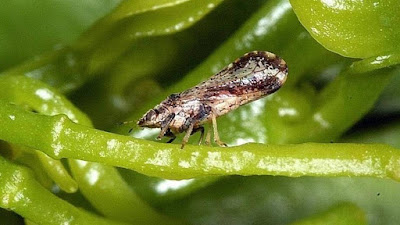
|
The Asian citrus psyllid is only an eighth-inch long, but it can carry a devastating disease.
(Photo: Courtesy CDFA)
|
Finding of first Asian citrus psyllid in Sacramento cause for alarm
How bad can one little bug be? When it comes to the Asian citrus psyllid, the consequences can be devastating.
Imagine California without oranges. That’s what this bug can do.
That’s also why agricultural authorities are so concerned about the discovery of one psyllid in south Sacramento.
Found in the Lemon Hill neighborhood, the singular psyllid prompted the California Department of Food and Agriculture to quarantine all of Sacramento County. Citrus trees, nursery stock and plant parts (except the fruit itself) cannot be moved out of the quarantine area.
It’s not the damage this invasive insect can do on its own. They’re itty-bitty sapsuckers with an appetite for new shoots of citrus trees, causing deformed growth. But it’s the disease these bugs carry that sets off alarm.
Only an eighth-inch long, the Asian citrus psyllid (
Diaphorina citri
) is the primary vector for the bacteria that causes Huanglongbing (HLB), one of the world’s worst citrus diseases. Nicknamed citrus greening disease, HLB causes citrus trees to produce bitter, ugly fruit that stays partially green. The tree itself suffers intense dieback before succumbing to the disease. There is no cure.
Florida had its first HLB case in 2005, according to reports. By 2008, most of its citrus farms were infected. According to the University of Florida Institute of Food and Agricultural Sciences, citrus greening is responsible for the loss of $4.64 billion in revenues from orange and grapefruit production in the decade since HLB took hold in that state. It also cost an estimated 3,700 jobs and $1.76 billion in lost labor income.
California’s citrus farmers are worried the same could happen here.
Researchers are working on ways to combat the disease and the bug. As of yet, there are no HLB resistant varieties; all citrus is susceptible.
Fortunately, the citrus psyllid has several natural predators including lady beetles, hoverflies, lacewings and parasitic wasps, according to University of California research. No one insecticide fully controls it. Read more here:
http://ipm.ucanr.edu/PMG/r107304411.html
The key to stopping this invasion will lie with backyard citrus growers. In 2012, the first California case of HLB was traced back to a home gardener who grafted a piece of infected scion wood onto a backyard citrus tree. Now, there are more than 1,100 cases of HLB in Los Angeles, Orange and Riverside counties.
Citrus psyllids have been spotted in the San Joaquin Valley and seem to be slowly creeping north, most likely hitchhiking on infected plant material.
The warning from the CFDA: Don’t buy a citrus tree in a quarantined area and move it to an uninfected county.
The Sacramento County Department of Agriculture set out 200 traps in the immediate area of the Lemon Hill find. In the meantime, Sacramento gardeners are asked to keep an eye out for possible psyllid activity.
Examine your citrus trees. The bug can be hard to see, but it leaves a distinctive trail of white waxy discharge that looks like little strings at the end of branches and growth tips on citrus trees.
If you see something, report it to the local or state ag office. Call CDFA’s pest hotline at 800-491-1899 or the Sacramento County agricultural commissioner at 916-875-6603.

